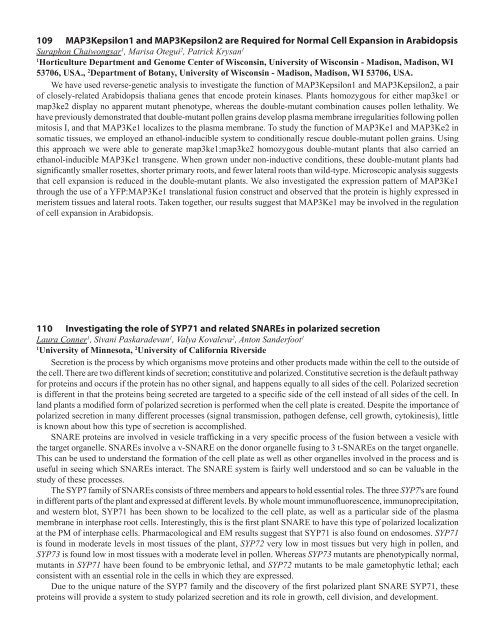75 Integrating Membrane Transport with Male Gametophyte ... - TAIR
75 Integrating Membrane Transport with Male Gametophyte ... - TAIR
75 Integrating Membrane Transport with Male Gametophyte ... - TAIR
You also want an ePaper? Increase the reach of your titles
YUMPU automatically turns print PDFs into web optimized ePapers that Google loves.
109 MAP3Kepsilon1 and MAP3Kepsilon2 are Required for Normal Cell Expansion in Arabidopsis<br />
Suraphon Chaiwongsar 1 , Marisa Otegui 2 , Patrick Krysan 1<br />
1<br />
Horticulture Department and Genome Center of Wisconsin, University of Wisconsin - Madison, Madison, WI<br />
53706, USA., 2 Department of Botany, University of Wisconsin - Madison, Madison, WI 53706, USA.<br />
We have used reverse-genetic analysis to investigate the function of MAP3Kepsilon1 and MAP3Kepsilon2, a pair<br />
of closely-related Arabidopsis thaliana genes that encode protein kinases. Plants homozygous for either map3ke1 or<br />
map3ke2 display no apparent mutant phenotype, whereas the double-mutant combination causes pollen lethality. We<br />
have previously demonstrated that double-mutant pollen grains develop plasma membrane irregularities following pollen<br />
mitosis I, and that MAP3Ke1 localizes to the plasma membrane. To study the function of MAP3Ke1 and MAP3Ke2 in<br />
somatic tissues, we employed an ethanol-inducible system to conditionally rescue double-mutant pollen grains. Using<br />
this approach we were able to generate map3ke1;map3ke2 homozygous double-mutant plants that also carried an<br />
ethanol-inducible MAP3Ke1 transgene. When grown under non-inductive conditions, these double-mutant plants had<br />
significantly smaller rosettes, shorter primary roots, and fewer lateral roots than wild-type. Microscopic analysis suggests<br />
that cell expansion is reduced in the double-mutant plants. We also investigated the expression pattern of MAP3Ke1<br />
through the use of a YFP:MAP3Ke1 translational fusion construct and observed that the protein is highly expressed in<br />
meristem tissues and lateral roots. Taken together, our results suggest that MAP3Ke1 may be involved in the regulation<br />
of cell expansion in Arabidopsis.<br />
110 Investigating the role of SYP71 and related SNAREs in polarized secretion<br />
Laura Conner 1 , Sivani Paskaradevan 1 , Valya Kovaleva 2 , Anton Sanderfoot 1<br />
1<br />
University of Minnesota, 2 University of California Riverside<br />
Secretion is the process by which organisms move proteins and other products made <strong>with</strong>in the cell to the outside of<br />
the cell. There are two different kinds of secretion; constitutive and polarized. Constitutive secretion is the default pathway<br />
for proteins and occurs if the protein has no other signal, and happens equally to all sides of the cell. Polarized secretion<br />
is different in that the proteins being secreted are targeted to a specific side of the cell instead of all sides of the cell. In<br />
land plants a modified form of polarized secretion is performed when the cell plate is created. Despite the importance of<br />
polarized secretion in many different processes (signal transmission, pathogen defense, cell growth, cytokinesis), little<br />
is known about how this type of secretion is accomplished.<br />
SNARE proteins are involved in vesicle trafficking in a very specific process of the fusion between a vesicle <strong>with</strong><br />
the target organelle. SNAREs involve a v-SNARE on the donor organelle fusing to 3 t-SNAREs on the target organelle.<br />
This can be used to understand the formation of the cell plate as well as other organelles involved in the process and is<br />
useful in seeing which SNAREs interact. The SNARE system is fairly well understood and so can be valuable in the<br />
study of these processes.<br />
The SYP7 family of SNAREs consists of three members and appears to hold essential roles. The three SYP7's are found<br />
in different parts of the plant and expressed at different levels. By whole mount immunofluorescence, immunoprecipitation,<br />
and western blot, SYP71 has been shown to be localized to the cell plate, as well as a particular side of the plasma<br />
membrane in interphase root cells. Interestingly, this is the first plant SNARE to have this type of polarized localization<br />
at the PM of interphase cells. Pharmacological and EM results suggest that SYP71 is also found on endosomes. SYP71<br />
is found in moderate levels in most tissues of the plant, SYP72 very low in most tissues but very high in pollen, and<br />
SYP73 is found low in most tissues <strong>with</strong> a moderate level in pollen. Whereas SYP73 mutants are phenotypically normal,<br />
mutants in SYP71 have been found to be embryonic lethal, and SYP72 mutants to be male gametophytic lethal; each<br />
consistent <strong>with</strong> an essential role in the cells in which they are expressed.<br />
Due to the unique nature of the SYP7 family and the discovery of the first polarized plant SNARE SYP71, these<br />
proteins will provide a system to study polarized secretion and its role in growth, cell division, and development.





